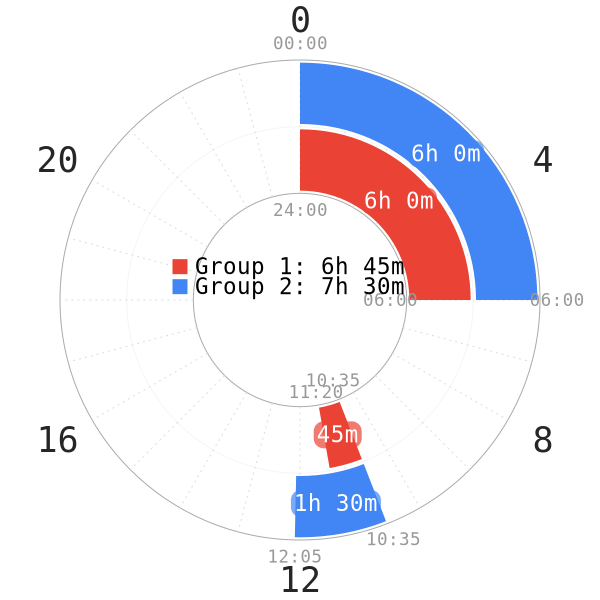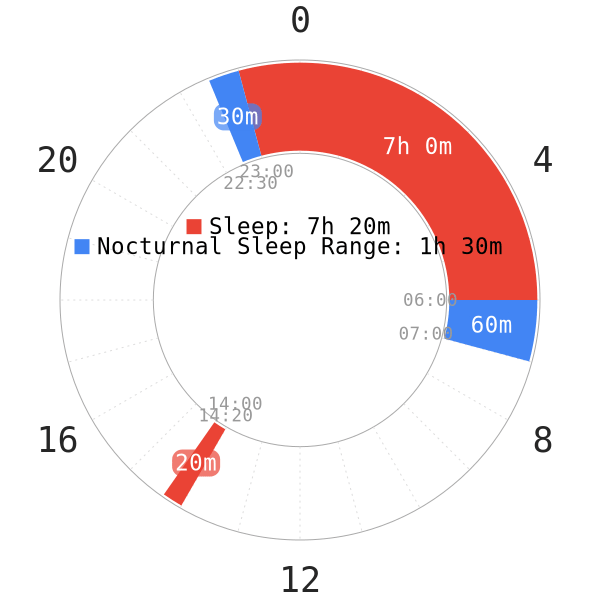Introduction
Dream content, while looking as frivolous as they appear, can actually reveal the unexpected. In fact, recently, there has been more research effort into understanding the nature of dreaming. While dreaming does manifest in a vast array of forms under many different situations, the dream world still gives much more to desire.
Over the years, many polyphasic sleepers in the community have dedicated time to logging their dream contents. And surprisingly, their dream contents often have certain things to say about their mental state, at least for short-term. Therefore, this blog post will attempt to illuminate how polyphasic sleep’s dreams can be related to the well-being of sleepers.
A Throwback to the Day-residue Dream Effect & the Sleep-Wake Continuity Theory
Polyphasic Dream Contents: The Day Residue & Dream Lag Effects
The above blog post already mentioned how humans’ waking experiences may incorporate into their dreams later at night. The sleeping-dreaming continuity has also gained traction for quite some time as well. It seems to support how dream elements tend to somewhat relate to personal waking experiences.
The focus of this blog post, however, is to discuss dream contents and mental health status of dreamers.
Dream Content & Overall Mental State
Right off the bat, it is clear that dream contents directly reflect current concerns and waking experiences. However, results can be surprising to new lucid dreamers, or polyphasic sleepers. Overall, while not the strongest indicators, what happens in a dream, especially on a consistent basis, can somewhat give hints on the current lifestyle.
Dream Content in Normal, Healthy Subjects
In healthy subjects, dream contents vary hugely. Holistically, their dreams overall do not give any red signals for their overall daily functions. This is not to say they never run into nightmares, however. While occasional bad dreams are extremely common and may suggest some individualistic omens, they are usually of no worries. The following points may be noteworthy:
- In a longitudinal study, participants’ dream series tended to improve when their psychological well-being during waking turned positive and vice versa1. This linear relationship further supports the relationship between waking experiences and dreaming elements.
- The thematic concerns in dreams spark a variety of topics, which revolve around everyday experiences2. Apparently, this includes both positive and negative contents, across both sexes, age groups and various ethnic groups.
- Such innocuous dreams include: being chased, naked, talking to others and other actions.
- As another example, it is common for the elderly to encounter dreams where they feel helpless and hopeless2.
Dream Content in Disturbed Subjects
On the contrary to healthy subjects, disturbed subjects do manifest very unique dream contents. This includes those who are temporarily undergoing a very harsh life crisis and those with chronic psychiatric disorders.
- A number of earthquake survivors in Pakistan reported more disturbing dreams during and following the traumatic event3.
- While there is no full consistency, depressed individuals often encounter dreams about escaping, sexuality and hostility1,2. Furthermore, their dream types are limited. Overall, their dreams are less “idealistic” than normal individuals.
- In a different study, insomniacs often had trouble coping with their personal real-life stressors. These elements do also tend to show up in their dreams frequently4. Their dream emotions were overall more negative and depressing regarding health concerns.
- Unusual sleep experiences, such as sleep paralysis, also imply dissociative waking experiences5. Specifically, dissociation is basically a waking experience where individuals get lost in the track of their actions. It is in a way similar to daydreaming and absent-mindedness, but of a starker degree.
- Recurrent dreamers scored low on personal self-reported well-being with more negative dream contents; however, past-recurrent dreamers and non-recurrent equivalents scored high and got more positive dreams6.
- A replicated study on recurrent dreamers specified that dream recurrence was a common plague in times of high stress7. As a result, the cessation of these dream series often improves psychological well-being. However, this improvement was interestingly only visible in adulthood, not early childhood.
Dream Contents in Polyphasic Sleeping
Nap Dreams
Up to date, there has been a very severe scarcity in napping and dream contents. This is because either nap dream contents may not be much different from those of nocturnal sleep, or that it indicates “sleep deprivation“. Such sleep deprivation measures are often considered “unhealthy” when researchers see REM sleep occur in mere 20-minute naps.
Regardless, we have been able to locate two studies with dream contents, napping and mood.
Study 1
The first study used a reducing biphasic schedule with 2h nocturnal sleep reduction and 45m nap and 90m “nap” for two group participants. Both of these naps locate around late morning hours (~10 AM). The following findings are noteworthy8:

- Both nap groups gave similar performance on recalling dream contents after waking from their naps. Specifically, their dream content recalling was not significantly different from each other.
- The longer nap gave a longer REM duration than the short nap. However, since it was a short-term study, we can only draw conclusions from the temporary partial sleep deprivation state.
- The longer-nap group felt better after sleeping than the short-nap group.
- Sad stories, or negative stimulus were their exposure before they napped. As a result, after awakening, both groups did experience some degree of sadness as their mood became reactive. However, the sadness occurred only because of the sad stories beforehand, which was part of their waking experiences.
In sum, the study did show that even dream contents in naps, waking experiences and some sleep reduction can simulate the temporary mental state quite well. The study also showed how REM-filled naps can affect mood and well-being in short term. However, assuming that this “adaptation” progresses, the mood swings from sleep deprivation effects may surface and override the effects of dream contents from either the nap or the core.
Study 2
This second study investigated the effect of a 20-minute afternoon nap on mood and performance. The following results and implications are worthwhile9:

- All subjects followed through this non-reducing E1 variant for short-term. They were also healthy sleepers with no sleep disorders and often slept soundly at night, from 6-8h.
- For the majority of subjects, their nap only contained NREM2. Three remaining subjects, however, experienced SOREM in their nap. None of the subjects had SWS in their nap.
- The naps were remarkably too short “to contain SWS”; hence, vigilance, performance and overall mood were enhanced after this nap.
- Notwithstanding, researchers considered individuals with SOREM naps “sleep deprived“. While this may be the case for non-reducing E1, it is unknown if the SOREM will persist if these non-nappers stick to napping everyday. Furthermore, it is also inconclusive if their long-term mood will suffer if they can protect their vital sleep stages daily, and continue to perform as well as they did in the study.
- Because of the nature of the nap and the schedule, dream recall was unlikely to be present in the nap. This is at least true for subjects with pure NREM2 nap.
While dream contents were not the focus of the study, it marks an “exception” that dreaming is NOT the ultimate tool to feel mentally good. Rather, tactical, consistent napping habits together with actual rest from the nap can boost personal mood and other well-being parameters. As such, NREM2 naps or absence of dream recalling are still beneficial for polyphasic sleepers.
Some Polyphasic Dreaming Anecdotes
Recently, we did conduct a survey from 18 adapted polyphasic sleepers in the Discord community. These sleepers managed to adapt to at least one polyphasic schedule in the past or present, and self-reportedly healthy. While no absolute conclusions can be drawn, these sleepers did share some interesting experiences with how dreaming correlates with their mental state.
- Those with a busy and stressful work or school schedules tend to run into “bad dreams” more often. This includes their own naps, not just core sleeps. Regardless, these bad dreams were mild and did not bother them too much.
- A lot of sleepers were able to experience a lucid dream or more after adapted.
- Three of them said that they used lucid dreaming as a technique to cope with stress. This is surprisingly in line with how lucid dreaming may be able to help depressed undergraduates10, although this solution remains controversial.
- The ability to “switch on” positive dream contents at will helps enhance mood and mentality of said polyphasic sleepers.
- While inconsistent, certain conditions or environments affect their dream contents. For example, being sad over personal work or life incidents reflect on similar dream contents. This is especially prevalent in a naturally Segmented sleeper with PTSD. For this reason, personally significant events during wake hours can still apply to different polyphasic schedules’ dream contents, not just with monophasic sleep’s.
- While many polyphasic sleepers do report intense dreams, those with huge REM baselines are not a good sign. This is because REM dream contents play some roles in certain health risks of excessive REM sleep11. However, more investigation in this facade is necessary.
Conclusion
Dream contents are not as useless as they appear to be. With all evidence showing their relationship with psychological well-being, it may be a concern for polyphasic sleepers. Our preliminary survey on self-reported dream contents do support the analyses on dream contents of normal, healthy monophasic sleepers.
However, given the limited survey participants, it remains unclear how polyphasic sleeping may help cope with stressful mental states. While polyphasic sleeping is known for creating huge dreaming reservoirs, it may not yield any real advantages to regular monophasic dreamers.
Main author: GeneralNguyen
Page last updated: 5 March 2021
Reference
- Pesant, N., & Zadra, A. (2005). Dream content and psychological well-being: A longitudinal study of the continuity hypothesis. Journal of Clinical Psychology, 62(1), 111–121. doi:10.1002/jclp.20212. [PubMed]
- Kramer, M. (1970). Manifest Dream Content in Normal and Psychopathologic States. Archives of General Psychiatry, 22(2), 149. doi:10.1001/archpsyc.1970.01740260053008. [PubMed]
- Najam, N., Mansoor, A., Kanwal, R. H., & Naz, S. (2006). Dream content: Reflections of the emotional and psychological states of earthquake survivors. Dreaming, 16(4), 237–245. doi:10.1037/1053-0797.16.4.237.
- SCHREDL, M., SCHAFER, G., WEBER, B., & HEUSER, I. (1998). Dreaming and insomnia: Dream recall and dream content of patients with insomnia. Journal of Sleep Research, 7(3), 191–198. doi:10.1046/j.1365-2869.1998.00113.x. [PubMed]
- Denis, D., & Poerio, G. L. (2016). Terror and bliss? Commonalities and distinctions between sleep paralysis, lucid dreaming, and their associations with waking life experiences. Journal of Sleep Research, 26(1), 38–47. doi:10.1111/jsr.12441/. [PubMed]
- Brown, Ronald, and D. Donderi. “Dream Content and Self-Reported Well-Being Among Recurrent Dreamers, Past-Recurrent Dreamers, and Nonrecurrent Dreamers.” Journal of Personality and Social Psychology 50.3 (1986): 612-623.
- Zadra, A. L., O’Brien, S. A., & Donderi, D. C. (1998). Dream Content, Dream Recurrence and Well-Being: A Replication with a Younger Sample. Imagination, Cognition and Personality, 17(4), 293–311. doi:10.2190/llxl-d4db-9cp5-brgt.
- Gilson, M., Deliens, G., Leproult, R., Bodart, A., Nonclercq, A., Ercek, R., & Peigneux, P. (2015). REM-Enriched Naps Are Associated with Memory Consolidation for Sad Stories and Enhance Mood-Related Reactivity. Brain Sciences, 6(1), 1. doi:10.3390/brainsci6010001/. [PubMed]
- Hayashi, M., Watanabe, M., & Hori, T. (1999). The effects of a 20 min nap in the mid-afternoon on mood, performance and EEG activity. Clinical Neurophysiology, 110(2), 272–279. doi:10.1016/s1388-2457(98)00003-0. [PubMed]
- Taitz, Isaac. “Learning lucid dreaming and its effect on depression in undergraduates.” (2011).
- McNamara, P., Johnson, P., McLaren, D., Harris, E., Beauharnais, C., & Auerbach, S. (2010). Rem And Nrem Sleep Mentation. International Review of Neurobiology, 69–86. doi:10.1016/s0074-7742(10)92004-7. [PubMed]
